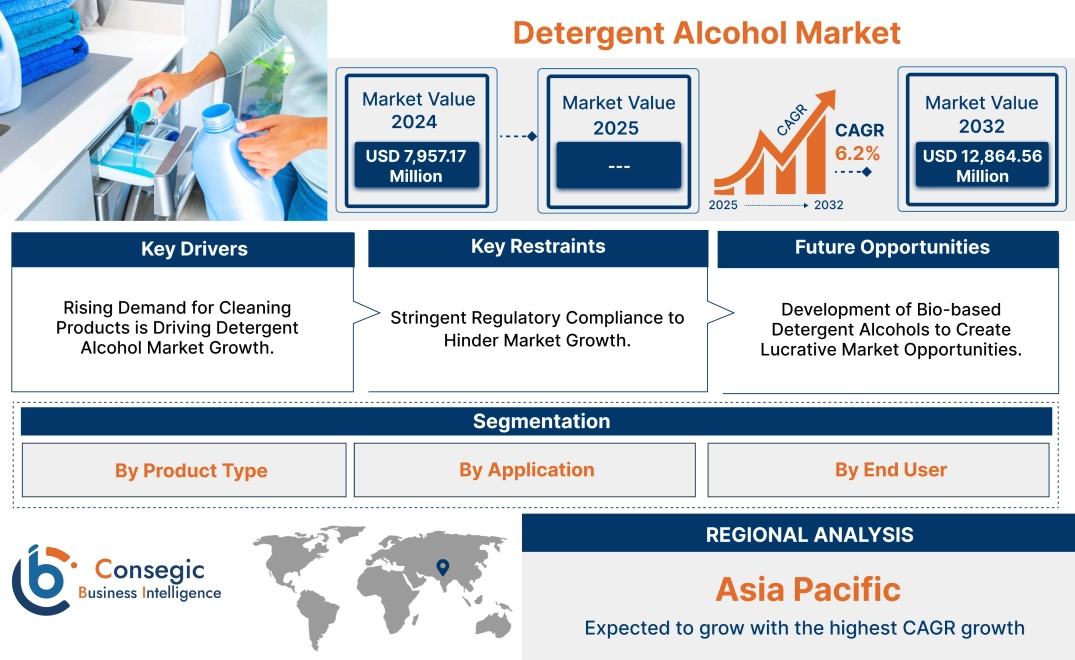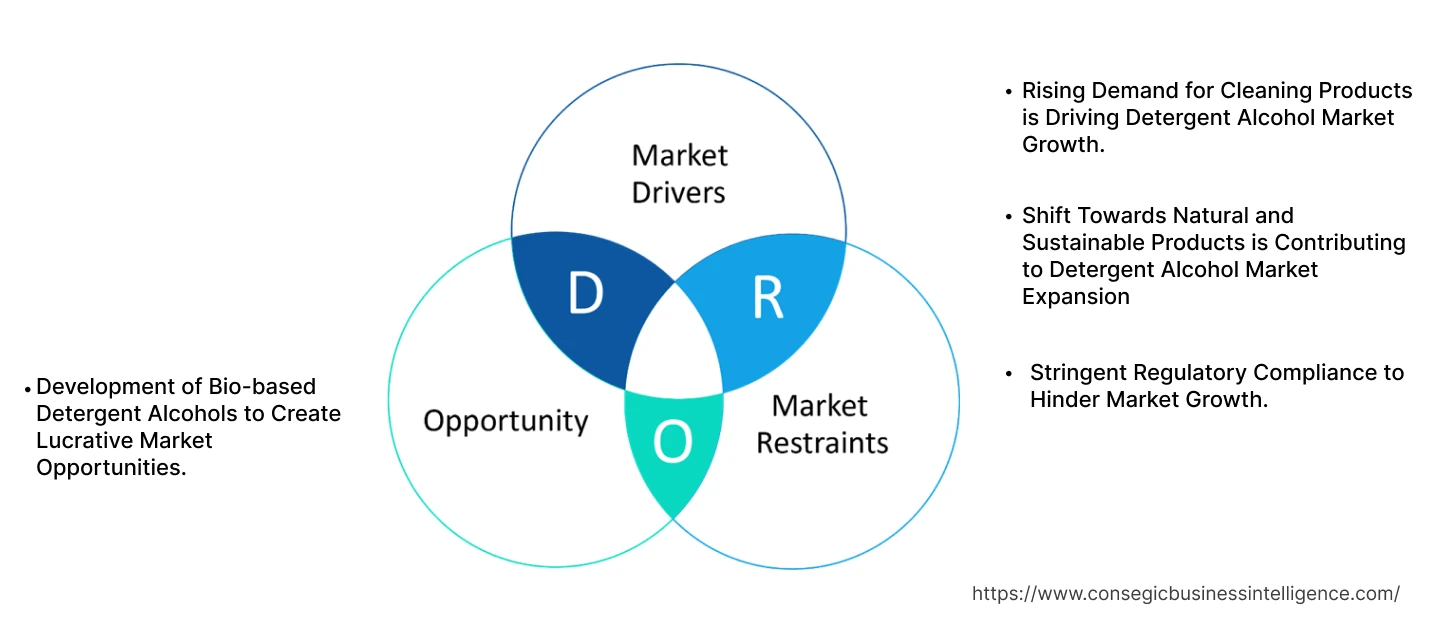- Summary
- Table Of Content
- Methodology
Detergent Alcohol Market Size:
The Detergent Alcohol Market size is growing with a CAGR of 6.2% during the forecast period (2025-2032), and the market is projected to be valued at USD 12,864.56 Million by 2032 from USD 7,957.17 Million in 2024.
Detergent Alcohol Market Scope & Overview:
Detergent alcohol (DA) is a solution that is used as ingredient in several products that are used for personal care and cleaning purposes. These alcohols show properties which help them to remove grease, dirt amongst others in an effective way. They reduce the tension of water due to their ability to act as a surfactant. This enables these alcohols to enter and wet the surfaces. In addition to this, these alcohols also have a characteristic to collaborate with both oil and water. This makes them a suitable and common option for cleaning purposes. Detergent alcohols are available in two different types such as natural and synthetic. Natural stating it being sourced from vegetable oils, amongst others. Similarly synthetic stating it being sourced from petrochemicals that have gone through a synthesis process. They are used in laundry detergents, shampoos, lotions, and others.
Key Drivers:
Rising Demand for Cleaning Products is Driving Detergent Alcohol Market Growth.
The rise in requirement for several cleaning products, particularly in the household sector is driving the market growth. The use of cleaning products such as hand sanitizer, detergent alcohol and several other agents that are incorporated for household cleaning purposes.
- For instance, according to an article published in Times of India, the home care products market has grown by roughly 27% CAGR from 2015 to 2023.
This growing focus on cleanliness apart from households is having a positive impact on the commercial and industrial areas as well. Thus, due to the rise in necessity of cleaning products is directly impacting on the growing requirement for detergent alcohol.
Shift Towards Natural and Sustainable Products is Contributing to Detergent Alcohol Market Expansion.
The growing awareness related to the side effects of synthetically derived products along with the inclination towards environment safety are contributing to the growing adoption of natural and sustainable products. These factors have impacted several sectors including the detergent alcohol industry. The consumer preference towards DA that are produced with the help of ingredients that are sourced naturally is rising.
- For instance, in 2024, a joint venture based in the U.S. known as Future Origins is aiming to develop ingredients that are sustainable in nature for personal care and cleaning products.
Thus, due to the above-mentioned factors, the shift towards natural and sustainable products is contributing to detergent alcohol market expansion.
Key Restraints:
Stringent Regulatory Compliance to Hinder Market Growth.
The increase in focus on protection of environment and safety of consumers has led to the imposing of stringent regulations that are required by the manufacturers to adhere to. These regulations are related to the production of detergent alcohol, its applicability, labelling of the product, amongst others. As manufacturers need to comply with these regulations, the production of DA is delayed as the process of the regulatory process is lengthy as well as time-consuming in nature. Additionally, this length of time process accounts for the increase in cost required for the production of these alcohols. Moreover, these factors also lead to delays in product innovations as manufacturers are required to think twice before investing in such products. Thus stringent regulatory compliance is hindering market growth
Future Opportunities :
Development of Bio-based Detergent Alcohols to Create Lucrative Market Opportunities.
The rise in developments towards detergent alcohol that are bio-based are creating opportunities for market growth over the forecast period. Bio-based alcohols are sourced from plant oils and fats that are renewable sources. They offer advantages when compared to the synthetically sourced alcohols. A few of these advantages are reduction in the environmental footprint.
- For instance, by the end of 2023, Ecogreen has decided to invest a substantial amount of money attributing roughly USD 50 million to expand its current production facility. This production facility produces detergent alcohols as the primary product
Thus, the biodegradable nature of these products are creating lucrative opportunities over the forecast period.
Detergent Alcohol Market Segmental Analysis :
By Product Type:
Based on product type, the market is categorized into natural detergent alcohol and synthetic detergent alcohol.
Trends in the Product Type:
- The consumer inclination towards cleaning products in the Household sector of natural source is rising.
The natural detergent alcohol segment accounted for the largest market share in 2024 and is expected to grow with the highest CAGR over the forecast period.
- The demand for natural detergent alcohol is increasing due to the preference of individuals focusing towards natural and sustainable products.
- These products have contributed to the reduction and have lessened negative impact on the environment
- Due to this, manufacturers operating in the market are focusing on developing DA with the source to be natural (oleochemical).
- For instance, according to Invest Saudi, a high percentage of detergent alcohols capacity is based on oleochemical (natural) feedstock. This percentage roughly attributes to more than 80% across the globe.
- Moreover, due to the complex nature of detergent alcohols, it is expected that the natural source will be preferred by consumers over the forecast period as well, when compared to its synthetic counterpart. Collectively, aforementioned factors support segment trajectory in the overall detergent alcohol market trend.
By Application:
The application segment is categorized into laundry detergents, dishwashing detergents, hard surface cleaners, personal care products, industrial cleaners, and others.
Trends in the Application
- The adoption rate for concentrated detergent alcohols for laundry in households is rising.
The laundry detergents segment accounted for the largest detergent alcohol market share of 39.34% in 2024.
- The laundry detergent is dominating the market due to the growing adoption of population as well as the increasing trend of individuals towards purchase of fancy clothing.
- In addition to this, it is observed that laundry detergent is a cleaning product in the household sector.
- DA are included in these detergents in a concentrated form in order to tailor to laundry application. A few of the applications are dependent on the fabric on which they are being used amongst others.
- Moreover, there is expected to be advancement in this segment such as the incorporation of detergent alcohols that are highly concentrated in nature along with their ability to remove stain.
- Owing to the above-mentioned factors, the laundry detergent segment is expected to dominate in the overall detergent alcohol market demand.
The personal care products segment is expected to grow at the fastest CAGR over the forecast period.
- The incorporation of detergent alcohol in personal care products is expected to rise due to approval of new types to cater to specific personal care concern.
- In addition to this, there has been an increase in changing lifestyles and the focus on hygiene per each individual is having a positive impact on market growth
- Detergent alcohol also acts as a surfactant. This is employed into several personal care products such as lotions, shampoos catering to specific personal care concerns as well as the overall concern.
- For instance, according to ICIS Chemical Business, C16-18 alcohols are few of the common detergent alcohols that are incorporated into personal care products. In these personal care products, the alcohol acts as an emulsifier, amongst others.
- Thus, due to the above-mentioned factors and trends, the personal care products segments are expected to register the fastest CAGR over the forecast period in the overall detergent alcohol market demand.
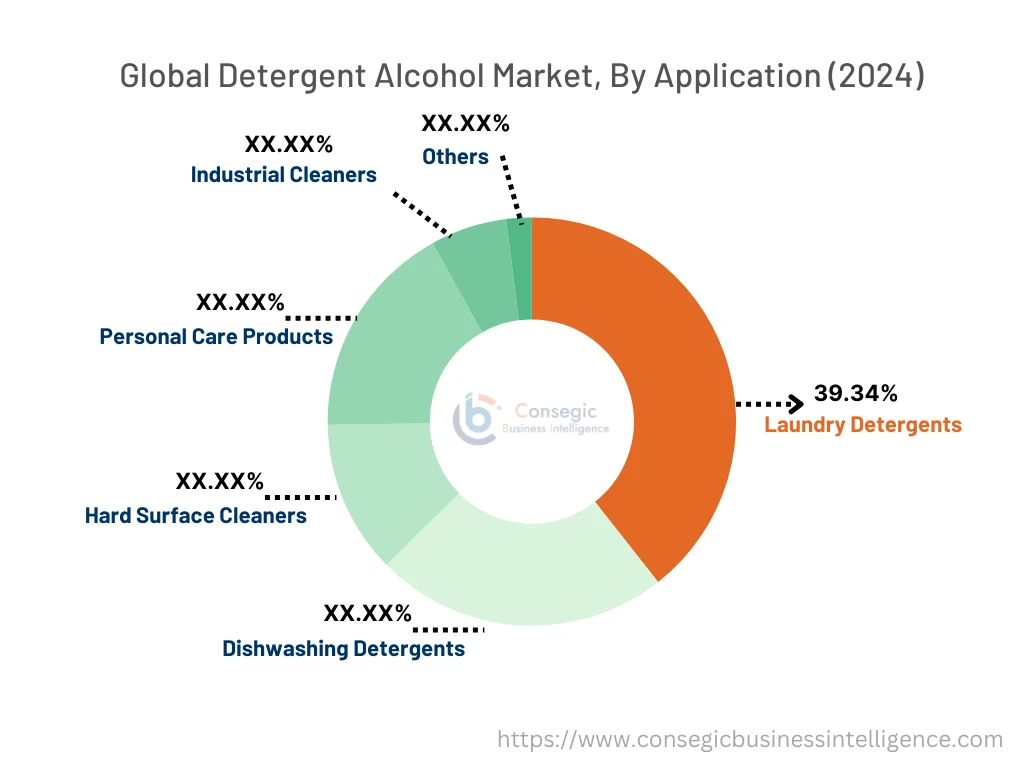
By End User:
Based on end user, the market is categorized into household, commercial, and industrial.
Trends in the End User:
- The increase in busier and hectic lifestyles has led to need for convenient cleaning solutions in the household sector.
The household segment accounted for the largest market share in 2024 and is expected to grow with the highest CAGR over the forecast period.
- The household segment is dominating the market due to the need for the cleaning product in the home care settings.
- The consumer inclination towards awareness of hygiene is further booting the need for detergent alcohols in its use as laundry detergent, dish washing detergents amongst others
- For instance, in 2024, according to the world population review, China has the highest number of household with an average 2.27 household members.
- Moreover, the need for easy to use and a convenient solution for busier and hectic lifestyle induced in end use for the household industry is growing.
- Thus, due to the above-mentioned factors, the household segment is dominating as well as expected to grow at the fastest rate over the forecast period in the overall detergent alcohol market trend.
Regional Analysis:
The regions covered are North America, Europe, Asia Pacific, the Middle East and Africa, and Latin America.
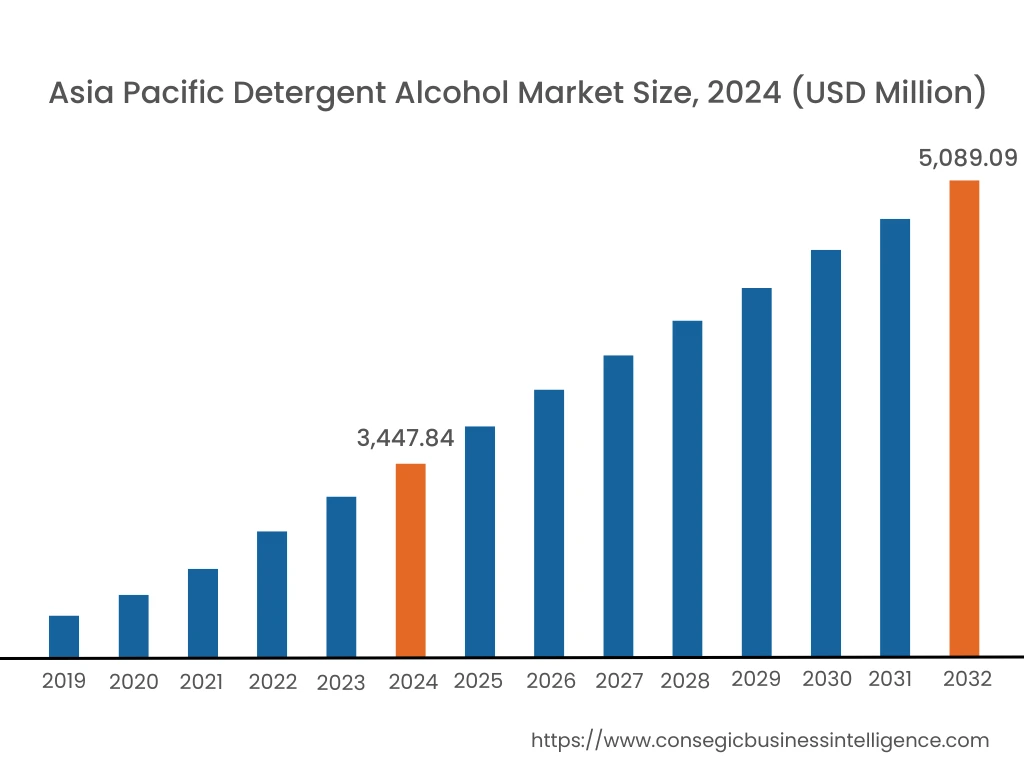
In 2024, Asia Pacific accounted for the highest detergent alcohol market share at 43.33% and was valued at USD 3,447.84 Million and is expected to reach USD 5,089.09 Million in 2032. In Asia Pacific, the China accounted for the largest share of 30.27% during the base year of 2024. The rising need for cleaning products is the key factors that is leading to the market trajectory of detergent alcohol in Asia Pacific. This surge in requirement and is fueled by a growing emphasis on hygiene and cleanliness. As populations in Asia Pacific continue to urbanize, there is a greater need for effective cleaning solutions for households, commercial spaces, and public areas. Additionally, increasing awareness of hygiene and cleanliness is increasing the necessity for effective cleaning and sanitizing products.
- For instance, in November 2024, Hindustan Unilever Limited and the Ministry of Housing and Urban Affairs signed a Memorandum of Understanding to launch the Centre of Excellence to help improve public hygiene & sanitation in India.
Therefore, as per market analysis, the increased need for cleaning products results in requirement for detergent alcohol, for the formulation of various cleaning agents in the Asia Pacific region.
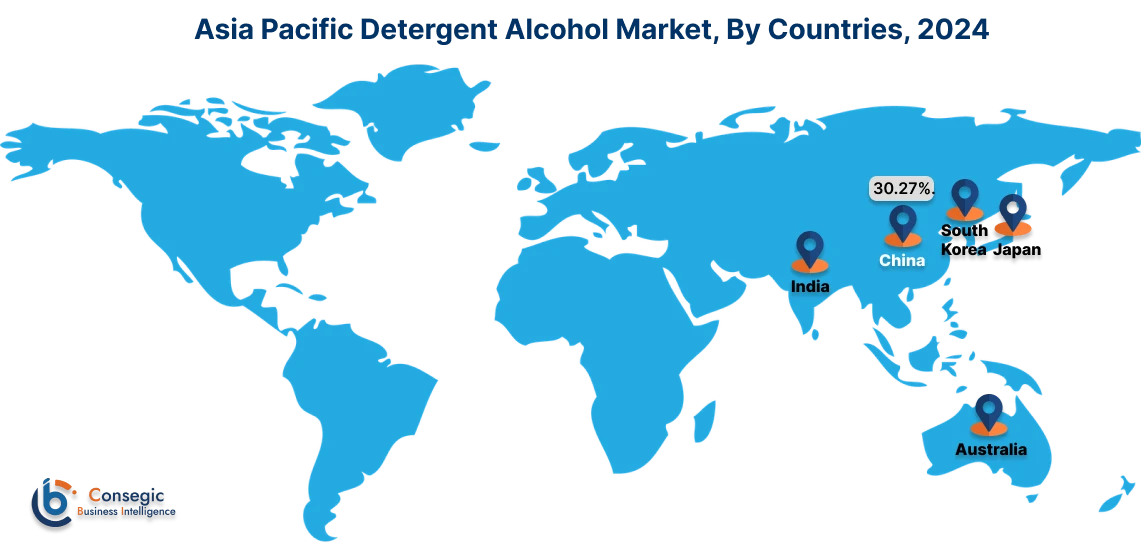
In Europe the detergent alcohol market analysis is experiencing the fastest growth with a CAGR of 8.59% over the forecast period. The increasing need and focus on development of bio-based detergent alcohols is one of the primary factors creating market demand across Europe. European countries present some of the strictest regulations across the globe. Hence, stringent regulations and consumer requirement is promoting European companies to invest in research and development to produce detergent alcohols from renewable sources. The development of bio-based detergent alcohol involves use biomass feedstocks to produce bio-based alcohols through natural. Collectively, increasing demand for bio-based detergent alcohol creates market demand across Europe.
Shift towards natural and sustainable products serves a prominent role detergent alcohol market growth in North America. American consumers are increasingly conscious of environmental and health impacts. This results in the high preference for products derived from natural sources and produced with sustainable practices. Hence, this growing requirement for eco-friendly and biodegradable ingredients is driving the adoption of detergent alcohols derived from renewable sources. As a result, key players are focusing on developing detergent alcohols derived from natural sources, further supporting detergent alcohols market opportunities in North America.
The consumers in Latin America are increasingly demanding more customized and personalized products. This trend is influenced because of the rise in the requirement of detergent products that cater to the specific needs and lifestyle changes. These changes have encouraged the manufacturers to produce and offer a wide range of formulations. These formulations consist of enhanced properties such as high viscosity, biodegradability, and foaming characteristics. Additionally, personalized services allow consumers to customize the properties of detergent such as the concentration of alcohol, and the fragrance among others. Thus, these factors are influencing the detergent alcohol market analysis.
The rapid urbanization and rise in the disposable income are primary factors that are influencing the rise in the use of home care products that consists of alcohol-based detergents. Additionally, consumers in this region are increasingly adopting modern lifestyle. This focuses on the rise in emphasis on cleanliness and hygiene. This rise in awareness is influencing the use of effective cleaning solution. They include laundry detergent, surface cleaner and dishwashing solution among others. These solutions readily utilize alcoholic detergent because of enhanced cleaning and emulsifying properties.
Top Key Players and Market Share Insights:
The global Detergent Alcohol Market is highly competitive with major players providing products to the national and international markets. Key players are adopting several strategies in research and development (R&D) and product innovation to hold a strong position in the global Detergent Alcohol market. Key players in the Detergent Alcohol industry include-
- Wilmar International Limited (Singapore)
- Kao Corporation (Japan)
- BASF SE (Germany)
- Stepan Company (US)
- Croda International Plc (UK)
- Emery Oleochemicals LLC (US)
- Kuala Lumpur Kepong Berhad (Malaysia)
- PT Astra Agro Lestari Tbk (Indonesia)
- Akema (France)
- PCC Rokita SA (Poland)
Detergent Alcohol Market Report Insights :
| Report Attributes | Report Details |
| Study Timeline | 2018-2032 |
| Market Size in 2032 | USD 12,864.56 Million |
| CAGR (2025-2032) | 6.2% |
| By Product Type |
|
| By Application |
|
| By End User |
|
| By Region |
|
| Key Players |
|
| North America | U.S. Canada Mexico |
| Europe | U.K. Germany France Spain Italy Russia Benelux Rest of Europe |
| APAC | China South Korea Japan India Australia ASEAN Rest of Asia-Pacific |
| Middle East and Africa | GCC Turkey South Africa Rest of MEA |
| LATAM | Brazil Argentina Chile Rest of LATAM |
| Report Coverage |
|
Key Questions Answered in the Report
How big is the Detergent Alcohol market? +
In 2024, the Detergent Alcohol market is USD 7,957.17 Million.
Which is the fastest-growing region in the Detergent Alcohol market? +
europe is the fastest-growing region in the Detergent Alcohol market.
What specific segmentation details are covered in the Detergent Alcohol market? +
By Product Type, Application and End User segmentation details are covered in the Detergent Alcohol market.
Who are the major players in the Detergent Alcohol market? +
Wilmar International Limited (Singapore), Kao Corporation (Japan), BASF SE (Germany) are some of the major players in the market.
